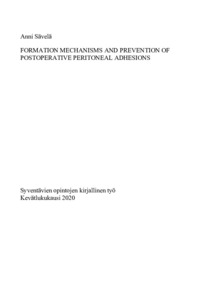Formation mechanisms and prevention of postoperative peritoneal adhesions
Sävelä, Anni (2020-03-13)
Formation mechanisms and prevention of postoperative peritoneal adhesions
Sävelä, Anni
(13.03.2020)
Julkaisu on tekijänoikeussäännösten alainen. Teosta voi lukea ja tulostaa henkilökohtaista käyttöä varten. Käyttö kaupallisiin tarkoituksiin on kielletty.
avoin
Julkaisun pysyvä osoite on:
https://urn.fi/URN:NBN:fi-fe2020040914202
https://urn.fi/URN:NBN:fi-fe2020040914202
Tiivistelmä
Postoperative peritoneal adhesions are a common complication
after operative treatment and they cause a significant burden to
both individual patients and the society. This review’s purpose
was to examine the mechanisms of postoperative peritoneal
adhesion formation and to evaluate different adhesion
prevention products that are either already available or being
investigated. The reference articles were searched using mainly
Primo Central Index.
Adhesions are formed when normal peritoneal healing is
somehow impaired. The peritoneal healing is a complicated
process and there are multiple stages that need to be completed
for normal healing to occur. If this is somehow interrupted, it
can lead to poor healing or adhesion formation instead of normal
healing. It is known that adhesions can be decreased by using
careful surgery techniques, but there are also some risk factors
that are related to the patient.
Modern adhesion prevention products can mainly be divided
into two groups: 1) barrier products that rely on the effect of
keeping wounded tissue surfaces mechanically apart, and 2)
immunomodulatory products that attempt to make the healing
process occur without adhesion formation by taking part in the
immunological pathways. Barrier products include solid
membranes, liquids and gels. Immunomodulatory products
include specifically targeted pharmacological agents as well as
multifunctional products.
Various different products have been investigated, but still the
optimal adhesion prevention product remains undiscovered.
Barriers are widely used, but immunomodulatory products have
shown some interestingly promising results. Whichever type of
product is used, it should be effective, affordable, safe and easy
to use.
after operative treatment and they cause a significant burden to
both individual patients and the society. This review’s purpose
was to examine the mechanisms of postoperative peritoneal
adhesion formation and to evaluate different adhesion
prevention products that are either already available or being
investigated. The reference articles were searched using mainly
Primo Central Index.
Adhesions are formed when normal peritoneal healing is
somehow impaired. The peritoneal healing is a complicated
process and there are multiple stages that need to be completed
for normal healing to occur. If this is somehow interrupted, it
can lead to poor healing or adhesion formation instead of normal
healing. It is known that adhesions can be decreased by using
careful surgery techniques, but there are also some risk factors
that are related to the patient.
Modern adhesion prevention products can mainly be divided
into two groups: 1) barrier products that rely on the effect of
keeping wounded tissue surfaces mechanically apart, and 2)
immunomodulatory products that attempt to make the healing
process occur without adhesion formation by taking part in the
immunological pathways. Barrier products include solid
membranes, liquids and gels. Immunomodulatory products
include specifically targeted pharmacological agents as well as
multifunctional products.
Various different products have been investigated, but still the
optimal adhesion prevention product remains undiscovered.
Barriers are widely used, but immunomodulatory products have
shown some interestingly promising results. Whichever type of
product is used, it should be effective, affordable, safe and easy
to use.
